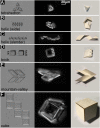Graphene-based bimorphs for micron-sized, autonomous origami machines
- PMID: 29295917
- PMCID: PMC5776973
- DOI: 10.1073/pnas.1712889115
Graphene-based bimorphs for micron-sized, autonomous origami machines
Abstract
Origami-inspired fabrication presents an attractive platform for miniaturizing machines: thinner layers of folding material lead to smaller devices, provided that key functional aspects, such as conductivity, stiffness, and flexibility, are persevered. Here, we show origami fabrication at its ultimate limit by using 2D atomic membranes as a folding material. As a prototype, we bond graphene sheets to nanometer-thick layers of glass to make ultrathin bimorph actuators that bend to micrometer radii of curvature in response to small strain differentials. These strains are two orders of magnitude lower than the fracture threshold for the device, thus maintaining conductivity across the structure. By patterning 2-[Formula: see text]m-thick rigid panels on top of bimorphs, we localize bending to the unpatterned regions to produce folds. Although the graphene bimorphs are only nanometers thick, they can lift these panels, the weight equivalent of a 500-nm-thick silicon chip. Using panels and bimorphs, we can scale down existing origami patterns to produce a wide range of machines. These machines change shape in fractions of a second when crossing a tunable pH threshold, showing that they sense their environments, respond, and perform useful functions on time and length scales comparable with microscale biological organisms. With the incorporation of electronic, photonic, and chemical payloads, these basic elements will become a powerful platform for robotics at the micrometer scale.
Keywords: atomic membranes; bimorph; graphene; origami; self-folding.
Conflict of interest statement
The authors declare no conflict of interest.
Figures




References
-
- In HJ, Lee H, Nichol AJ, Kim S-G, Barbastathis G. Carbon nanotube–based magnetic actuation of origami membranes. J Vac Sci Technol B Microelectron. 2008;26:2509–2512.
-
- Zhang Q, et al. Origami and Kirigami inspired self-folding for programming three-dimensional shape shifting of polymer sheets with light. Extreme Mech Lett. 2017;11:111–120.
-
- Na JH, et al. Programming reversibly self-folding origami with micropatterned photo-crosslinkable polymer trilayers. Adv Mater. 2015;27:79–85. - PubMed
-
- Yang SY, Choi H-rJ, Deterre M, Barbastathis G. Nanostructured origami™ folding of patternable resist for 3D lithography. In: Toshiyoshi H, editor. Proceedings of the Optical MEMS and Nanophotonics (OPT MEMS) 2010 International Conference. IEEE; Piscataway, NJ: 2010. pp. 37–38.
-
- Tu H, Jiang H, Yu H, Xu Y. Hybrid silicon-polymer platform for self-locking and self-deploying origami. Appl Phys Lett. 2013;103:241902.
Publication types
LinkOut - more resources
Full Text Sources
Other Literature Sources
Research Materials

